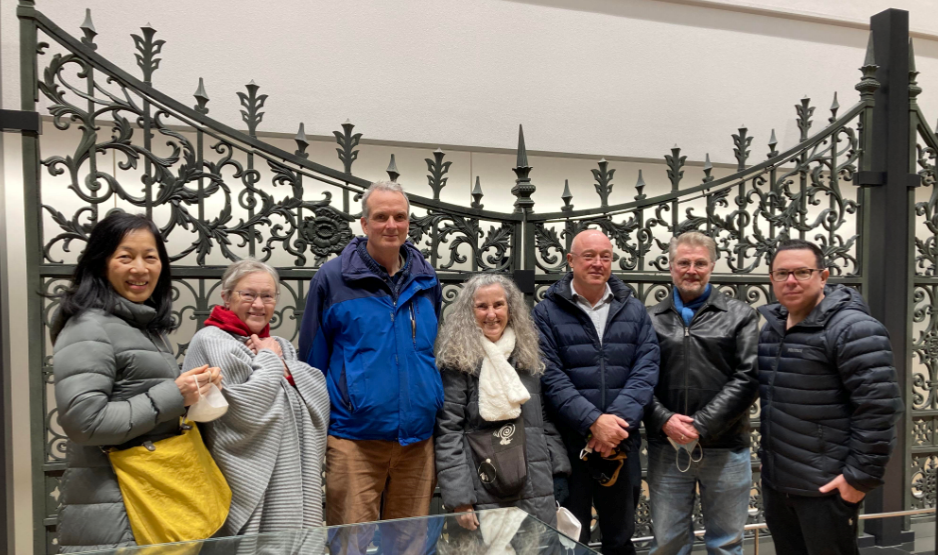Jan. 21, 2023 at Ryukoku University Omiya Campus
On January 21, nine people gathered to hear Timon Screech’s talk, which was abundantly illustrated with interesting photographs. This talk was organized by WiK with the locale assistance of Paul Carty.
Timon Screech has about 20 books to his credit, including Tokyo before Tokyo and The Shogun’s Silver Telescope. His speaking style reflects his enthusiasm, especially for interesting sidelights on history which illuminate international trade, diplomatic connections, and political machinations. This talk was a good example of this.
It had been a while since I thought about Japanese history, and it is heartening to realize that people like Timon Screech make it their life’s work, as it is so fascinating in so many ways. The title made me wonder what, in this context, is meant by “avatar”, which is defined as an embodiment or symbol, in human form, of a concept, philosophy, or deity. It had not occurred to me to think of Tokugawa Ieyasu in this context, so it filled in some blanks for me with regard to one of the most important characters in Japanese history.
It seems impossible to talk about Ieyasu, the Great Unifier of Japan, without talking about his predecessor, Toyotomi Hideyoshi. The beautiful and ornate mausoleum of Ieyasu in Nikko, in the north of the Kanto Plain, echoes that of Hideyoshi at Amidagamine in the foothills of Kyoto.
Many historical figures sought “deification” as avatars of Shinto kami 神, or Buddhist figures. They also sought connection with the Imperial Family in order to confer legitimacy on their government, especially those in the new “eastern” capital, Edo, home of the shogunate, which was considered barbaric compared to the “western” court of Kyoto, where the Emperor resided. Both Hideyoshi and Ieyasu desired this kind of connection.
It is important to remember that at this period of history, Buddhist temples and Shinto shrines were not differentiated as they were later. For example, personalities like Sugawara no Michizane became the avatar of Monju Bosatsu (a Buddhist saint and patron of education) and was also, as a kami, associated with Kitano Tenmangu Shrine in Kyoto.
In any case, the warriors who began the shogunate knew that they were looked down on by the Kyoto court, and by associating themselves with dieties and other important figures sought to give an air of legitimacy to their Eastern area. Thus, Ieyasu was made a daimyojin, the highest level of kami, and also became an avatar of the Buddhist deity Yakushi Nyorai; the person engineering this was a Tendai (Mt. Hiei in Kyoto) monk called Tenkai, who was charged with rehabilitating the ancient historical site of Nikko. In the process he started the cult of Ieyasu at that place. This mausoleum is referred to as Toshogu, “the shrine of Tosho”. Tosho was the posthumous name given to Ieyasu, and gu is an Imperial shrine. Nikko means “light of the sun”, (a word describing the Emperor), and the fact that this site was in the East, which is associated with the sun, bound these close together. Specifically, Tokugawa Ieyasu was seen as a light (lantern) which assisted the sun of the Emperor, and the lantern became a symbol of this; many different and interesting lanterns are scattered around the Nikko mausoleum. Lanterns are also used in the worship of Yakushi Nyorai.
For example, a metal lantern, which is a copy of the one at Daitokuji in Nara was donated by Ieyasu’s granddaughter, Masako, who was married to Cloistered Emperor Go-Mizuno-O. Others included two metal lanterns donated by Date Masamune, a famous general of both Hideyoshi and Ieyasu, and three of Dutch manufacture, which were purported to be gifts from Holland, Okinawa and Korea through various political and diplomatic machinations.
There is a very complex hierarchy of lanterns, both those who donated them and those before whom they were burned. The material of metal was the highest level of this hierarchy.
Timon Screech said he is presently working on a book on the topic of this talk. We await the appearance of this book, which will certainly shed light for readers of English on this interesting and important part of Japanese history. Our thanks to him for speaking to us.
* * *
Information about Timon’s academic background can be found within the original event listing at this link.

